23.02.2022
Sugar loading is not required for phloem sap flow in maize plants
In plants there is no heart to pump nutrients and photoassimilates through the phloem, which is part of the leaf veins. According to the pressure flow hypothesis, transport in the phloem occurs because sucrose is actively loaded into the phloem in photosynthetically active tissues, which creates an osmotic pressure and thus a so-called mass flow in the phloem. The sugars are then discharged and used elsewhere in the plant, e.g. in the roots.
This hypothesis was developed by Ernst Münch in the 1930s. An international team of research groups from the US and Germany, in which the molecular plant research/plant biochemistry group of Prof'in Dr. Gertrud Lohaus participated, was able to show that phloem transport is also possible when hardly any sucrose is loaded into the phloem. Further investigation of this surprising result showed that potassium can play the role of sucrose (Nature Plants article).
08.02.2022
Issue cover in ChemPhotoChem - Let there be light
The need to switch from fossil energy sources to more sustainable ones puts an emphasis on alternatives like solar energy. To reflect this change in chemical education, curricular innovations and new teaching materials are in need.
Our researchers in the Didactics of Chemistry group have explored experimental approaches and developed teaching materials in photochemistry for more than 20 years now. Prof. Claudia Bohrmann-Linde and the former head of our Didactics of Chemistry Prof. Michael Tausch state that light-involving phenomena are most suitable for the communication of core concepts of chemistry and related sciences (physics, biology, geography and information technology).
In close collaboration their workgroups have built a large open-access online repository containing their experiments and teaching materials. The offered videos and materials are available in German and English and combine every day experiences of students with scientific research and innovative technological applications.
Their recently published article (full text pdf) in ChemPhotoChem features two groups of experiments suitable for teaching basic concepts of photo-chemistry - the molecular switch spiropyran/merocyanine and the photoactive n-type semiconductor titanium dioxide.
27.11.2021
Effects of an Interdisciplinary Course on Pre-Service Primary Teachers’ Content Knowledge and Academic Self-Concepts in Science and Technology–A Quantitative Longitudinal Study
Primary school teachers need adequate professional knowledge and motivational orienta-
tions to qualify scientifically and technologically literate students. Previous studies have focused on
the impact of coursework on (pre-service) primary teachers’ content knowledge, rather than on the
development of academic self-concepts. In addition, the influence of the course format and the major
field of study has not been investigated much to this date. Thus, this study examines the effects
of an interdisciplinary course on pre-service primary teachers’ content knowledge and academic
self-concepts in science and technology using a quasi-experimental, quantitative, pre-post-follow-up
design (n = 202). Whilst no significant changes in knowledge were revealed for the baseline group not
participating in the course, significant short-term and long-term cognitive gains were found for the
experimental group. Biology-, chemistry-, physics- and technology-related self-concepts increased
significantly when participating in the course. The results also indicate that the course format and
major field of study can have an impact on the development of pre-service teachers’ professional
knowledge. Regarding the development of academic self-concepts in the experimental group, it can
be assumed that both the weekly and block course format are beneficial for heterogeneous learner
groups consisting of pre-service teachers with different major fields of study.
20.10.2021
Two Piwis with Ago-like functions silence somatic genes at the chromatin level
Most sRNA biogenesis mechanisms involve either RNAse III cleavage or ping-pong amplification by
different Piwi proteins harbouring slicer activity. Here, we follow the question why the mechanism of
transgene-induced silencing in the ciliate Paramecium needs both Dicer activity and two Ptiwi proteins.
This pathway involves primary siRNAs produced from non-translatable transgenes and secondary siRNAs
from targeted endogenous loci. Our data does not indicate any signatures from ping-pong amplification
but Dicer cleavage of long dsRNA. Ptiwi13 and 14 prefer different sub-cellular localizations and different
preferences for primary and secondary siRNAs but do not load them mutually exclusive. Both Piwis
enrich for antisense RNAs and show a general preference for uridine-rich sRNAs along the entire sRNA
length. In addition, Ptiwi14-loaded siRNAs show a 5 ́-U signature. Our data indicates both Ptiwis and 2
́-O-methylation contributing to strand selection of Dicer cleaved siRNAs. This unexpected function of
the two distinct vegetative Piwis extends the increasing knowledge of the diversity of Piwi functions in
diverse silencing pathways. We describe an unusual mode of action of Piwi proteins extending not only
the great variety of Piwi-associated RNAi pathways but moreover raising the question whether this could
have been the primordial one.
18.10.2021
Monitoring Behaviour in African Elephants

African elephants are highly social animals. In the wild, they perform a so-called Greeting Ceremony when meeting familiar elephants which they haven´t seen for a certain timespan. Until now, it has been unknown whether zoo elephants show this unique behaviour as well. In this study (full text pdf), Franziska Hörner, who is working in our Zoology group led by Prof. Gela Preisfeld, set out to answer this question.
Therefore, the Preisfeld group designed this study around the reunifications of two mother–daughter pairs that had been separated for 2 and 12 years. As a comparison two unifications of unrelated elephants were observed. To prevent possible fighting, the first contact was conducted in a protected setting with a fence between the animals. Signs of the Greeting Ceremony shown by the elephants, the distance they kept to the separating fence, and the time until the elephants’ trunks touched for the first time were observed.
The results demonstrate that the related elephants showed all behavioural characteristics of the Greeting Ceremony, kept close to the fence, and touched trunks after only a few seconds, while elephants that were not familiar with each other did not show a full Greeting Ceremony, stayed further from the fence, and touched trunks for the first time only after several minutes upon meeting. They were able to show that zoo elephants behave species-specific by carrying out the same typical Greeting Ceremony known from wild elephants. It also confirms the strong family bonds of elephants and the cognitive abilities of elephants, specifically their long-term social memory.
28.09.2021
Scherf group published in Nature
In a long-term cooperation between the IBM Research Europe and the groups led by Rainer Mahrt (IBM Research Zurich, Switzerland), Pavlos Lagoudakis (SkolTech University, Moscow/Russia, and University of Southampton, UK), and our BUWMakro group the article "Single-photon nonlinearity at room temperature" has been published in Nature.
The paper describes quantum phenomena of conjugated polymers with a so-called strong coupling between the polymer chains at room temperature in a specially designed microcavity under formation of exciton-polariton condensates. The Scherf group provided (and still provides) the tailor-made conjugated polymer materials used.
24.08.2021
Three new publications by the Scherf Group
In a joint article with the group of Prof. Sergio Seixas de Melo (University of Coimbra/Portugal) in Macromol. Rapid. Commun. (full text pdf) the Scherf group published the synthesis of polymers with diazapentacenium repeat units, made in a simple two-step sequence (C-N cross-coupling and post-polymerization cyclization) from appropriately designed AA/BB-type monomers. The high redox activity of the diazapentacenium building blocks suggests interesting electrochromic properties.
Another article from the same collaboration was recently published in Macromolecules (full text pdf). Here, they describe the synthesis and spectroscopic properties of graft copolymers with a polyfluorene (PF) backbone and grafted, temperature-responsive poly(isopropylacrylamide) (PNIPAM) side chains.
In a special issues honoring Kees Hummelen (Groningen University) as a pioneer of fullerene chemistry, in the journal J. Mater. Chem. C, the synthesis of novel conjugated hydrocarbon ladder polymers with a polyacene-like backbone is reported (full text pdf). This article resulted from a cooperation project between the Scherf group and the groups of Prof. Sergio Seixas de Melo (Physical Chemistry, University of Coimbra/Portugal), Prof. Hilke Bahmann (Theoretical Chemistry, Saarbrücken University), and Prof. John Lupton (Experimental Physics, Regensburg University). The aromatic ladder polymers show an unexpectedly high conformational flexibility of the double-stranded backbone, which is documented in the spectroscopic properties in the ensemble and of individual chains.
10.05.2021
Sequence‐selective covalent CaaX‐box receptors prevent farnesylation of oncogenic Ras proteins and impact MAPK/PI3K signaling
The Scherkenbeck group recently published a new paper on an alternative strategy to prevent farnesylation and subsequent membrane insertion, a prerequisite for the activation of Ras proteins.(full text pdf).
Oncogenic Ras proteins are implicated in the most common, live‐threatening cancers. Despite intense research during the past two decades, the progress towards small‐molecule inhibitors has been limited. One reason for this failure is, that Ras proteins interact with their effectors only via protein‐protein interactions which are notoriously difficult to address with small organic molecules. The approach described is based on sequence‐selective supramolecular receptors which bind to the C‐terminal farnesyl transferase recognition unit of Ras and Rheb proteins and covalently modify the essential cysteine in the so‐called CaaX‐box.
24.04.2021
Five recent publications by the Scherf group
The first article in Chem. Eur. J. describes a simple 2-step synthesis of diazapentacenium salts and their solvatochromism, based on the formation of supramolecular aggregates. The second paper in Materials Advances, like the first article a collaboration project with the Sergio Seixas de Melo group at Coimbra University/Portugal, reports synthesis and spectroscopic properties of conjugated donor-acceptor copolymers with photoluminescence reaching into the near infrared (NIR) region.
The third paper was prepared in a collaboration with the George Floudas group at Ioannina University/Greece on ionic conjugated diblock copolymers and their ionic conductivity. This is the 50th Macromolecules (ACS) paper of the Scherf group after 30 years of polymer research in Jena, Mainz, Potsdam, and Wuppertal. The first Macromolecules paper was published with Klaus Müllen in 1992 (pdf).
The forth article in Organic Materials was prepared together with the Thomas Riedl/BUW and John Lupton/Universität Regensburg groups and is published in a special issue dedicated to Peter Bäuerle/Universität Ulm, a pioneer of Organic Photovoltaics in Germany. It reports a novel method for the synthesis of poly(anthrylene ethynylene)s.
The last article was published in Nanomaterials and is an afterthought of a completed pre-Brexit EU project (LAMP) on semiconductor nanoparticles/polymer hydrides, in cooperation with the Ifor Samuel group at St. Andrews University/UK.
01.03.2021
Polymer materials for experiments on tunable exciton-polariton condensation in a two-dimensional lattice
As a cooperation with Stöferle group at the IBM Research Europe/Zurich, the Scherf group has been providing active polymer materials for the generation of exciton-polariton condensates in the strong interaction regime between light and matter for many years. These condensates have quantum fluid properties up to room temperature.
The current publication in Communications Physics (full text pdf) describes the polariton condensation at room temperature in a nano-fabricated, two-dimensional Lieb lattice. These are key first steps in studying topological polariton systems under ambient conditions.
04.02.2021
Electrooxidative generation of polymer films from rigid tricarbazole monomers
The Scherf groups new open-access paper reports the electropolymerization of a series of five rigid tricarbazole monomers, three planar triphenylene-cored tricarbazoles and two triptycene-cored derivatives. Oxidative electropolymerization of these monomers leads to a continuous growth of smooth and freestanding thin films. Moreover, one class of polymer films shows the occurrence of intrinsic microporosity.
29.10.2020
More about Polymer/single-walled carbon nanotube hybrid materials
In collaboration with Dr. Mario Caironi, Istituto Italiano di Tecnologia, Milano, and Prof. Maria Antonietta Loi, University of Groningen, the Scherf group studied the charge transport mechanism in high-mobility, inkjet-printed field-effect transistors. (full text pdf).
10.10.2020
Neuronal networks meet carbon nanotubes
Truly interdisciplinary research projects allow chemists to enter fields that are normally inaccessible. A collaboration between Prof. Maria Antonietta Loi, University of Groningen, and the Scherf group started research into materials in which layered neural networks can be implemented. Artificial neural networks promise efficient computation for specific tasks that are expensive or even impossible for usual computers. For the fabrication of artificial synapses based on simple bottom-gate field-effect transistors (FETs) they used high-quality semiconducting single-walled carbon nanotube (s-SWCNT) inks (read more).
30.09.2020
Generation of heterocyclic scaffolds by ring expansion

The Kirsch group recently reported a novel ring expansion based on the readily available 2-azido-2-phenyl-indan-1,3-dion leading to 3-amino-2,3-dihydroisoquinoline-1,4-diones with an unprecedented substitution pattern and an undescribed tricyclic 1,10a-dihydroimidazo-isoquinoline-2,5,10-trione scaffold (full text pdf).
Ring expansion reactions are used in the generation of nitrogen-containing heterocycles as well as in the synthesis of many natural products and pharmacologically active substances. The Kirsch group was successful in preparing 3-amino-2,3-dihydroisoquinolin-1,4-diones by treating 2-azido-indan-1,3-dione with primary amines and cesium carbonate in a two-step synthesis. They even expanded this method producing 1,10a-dihydroimidazo-isoquinoline-2,5,10-triones, possessing an unprecedented tricyclic scaffold, in a one-step procedure by using amino acid methyl esters and DIPEA.
These two uncommon heterocyclic structures harbor potential as versatile starting points for further functionalization, which the Kirsch group will explore in future work.
29.09.2020
A short three‐step synthesis to produce all four stereoisomers of Harzialactone A using standardized polyketide building blocks

The Kirsch group recently published a short, convenient, total synthesis of the natural product Harzialactone A and its three stereoisomers starting from benzaldehyde (full text pdf).
Due to its potential antitumor and cytotoxic activity as well as its leishmanicidal activity Harzialactone A is an interesting target compound for synthesis. Mimicking the natural biosynthetic pathway of polyketides such as Harzialactone A is a challenging task. To simplify this challenge, the Kirsch group developed a chiral building block that can be easily attached onto a growing carbon chain. In a first step, a Horner–Wittig‐reaction of this chiral building block and benzaldehyde is utilized (depicted to the left). In a short four step iteration sequence (consisting of said Horner–Wittig reaction followed by reduction, protection and ozonolysis) the Kirsch group produced Harzialactone A and its stereovariants at excellent enantio‐ and diastereopurities.
The Kirsch group plans to use and adapt the methodology established here for future synthesis of more complex polyketidic structures.
21.09.2020
New photoresponsive materials for optical memory devices and light sensors
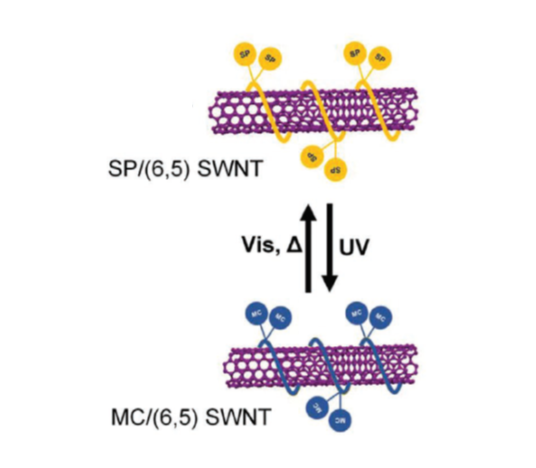
In the frame of a joint, DFG-funded research project between the research groups surrounding Prof. Ullrich Scherf (University of Wuppertal) and Jana Zaumseil (University of Heidelberg) the Scherf group generated conjugated polymers with photoresponsive spiropyran substituents that can be wrapped around single-wall carbon nanotubes (full text pdf).
Such hybrid materials show irradiation-induced changes of their electronic properties, here their electric conductivity. These changes are reversible by applying a thermal post-treatment. Thin film devices based on these photoresponsive polymer/nanotube hybrids show potential as resettable UV dosimeters and optical memory elements.
17.08.2020
Polyphenols inhibit CYP-catalyzed oxylipin formation
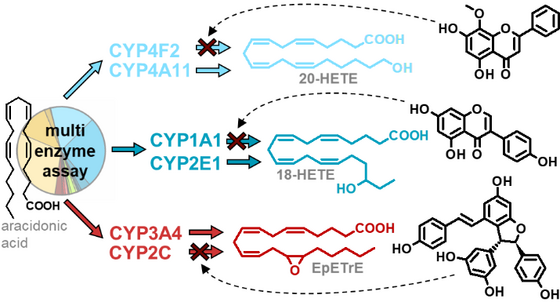
The Schebb group recently showed that the cytochrome P450 monooxygenase branch of the arachidonic acid cascade can be inhibited by dietary polyphenols (full text pdf).
Cytochrome P450 monooxygenases (CYP) catalyze the oxidation of arachidonic acid to i.e. epoxy- and hydroxy-fatty acids. The oxylipins resulting from this arachidonic acid cascade include lipid mediators such as prostaglandins, which are involved in the regulation of many physiological processes such as pain, inflammation and cell signaling. Nadja Kampschulte, a Phd student in the Schebb group, tested a library of polyphenols and found that dietary polyphenols are able to inhibit the CYP-mediated oxylipin formation with remarkable structure-dependent selectivity and potency.
Future research will be focused on understanding the connection between the discovered inhibitory function and the chemical structure of the polyphenols. This new molecular mechanism found by the Schebb group sheds a new light on the role and potential of polyphenols in human diet and health.
10.08.2020
Structural Diversity and Antibacterial Activity of Silver(I) Complexes
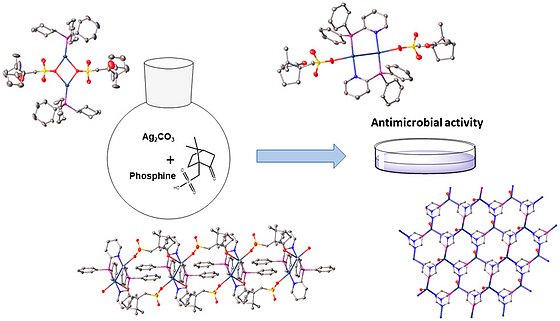
The Mohr group recently published work on the antibacterial and antifungal activity of silver(I) complexes with camphorsulfonato and phosphine ligands (full text pdf).
Julia Kuchar – a PhD student in the Mohr group - prepared a series of silver(I) camphorsulfonato complexes containing a variety of phosphine ligands. These complexes were fully characterized by NMR spectroscopic methods and X-ray crystallography. They observed a number of different supramolecular structures in the solid state depending on the nature of the phosphine.
The in vitro antimicrobial activity in seven different pathogens (five bacteria and two fungi) as well as toxicity in human cells was studied in collaboration with the Community for Open Antimicrobial Drug Discovery (CO-ADD, University of Queensland, Australia). The compounds were found to be active against both gram-negative and gram-positive bacteria. Furthermore, they showed an even higher activity against fungi, especially C. neoformans.
16.07.2020
Activation of Metal-Halogen Bonds by Halogen Bonding

In collaboration with the groups of Prof. Huber (Ruhr University Bochum) and Prof. Legault (Université de Sherbrooke) the Kirsch group recently published a new method for Au-Cl bond activation via halogen bonding (full text pdf).
Two gold-catalyzed test reactions were performed in presence of halogen bond donors. In this setting, iodolium derivatives were found to be effective activators and their activity could be modulated by blocking of the Lewis acidic sites. An even more rapid conversion was achieved with bis(benzimidazolium)‐based halogen bonding activators. These proof-of-principle experiments as well as additional NMR experiments indicate that halogen bonds may be responsible for the formation of active catalysts from inactive gold-chloride pre-catalysts. These findings are supported by theoretical DFT calculations.
This new method for activation of gold-chloride employs a scarcely used interaction. Bearing the potential to be used in heterolysis of other metal-halogen bonds, this method opens up a multitude of possibilities for future applications.
12.07.2020
Reduction of nitrogen oxides in the vicinity of street tunnels by photocatalytic reactors („TunNOx“)
The Kleffmann group takes part in a joint research project with the RTWH Aachen. Their work is funded as part of the „Innovationsprogramm Straße“ of the „Bundesanstalt für Straßenwesen“ (BAST).
In the present project, different methods for photocatalytic reduction of nitrogen oxide (NOx) levels in the outflow from ventilated road tunnels will be investigated. The study aims to improve our knowledge of the use of linear photocatalytic reactors, which can be implemented in tunnel ventilation systems. Besides improved knowledge of the integration of this innovative technique during the construction of new tunnels, the possibility of the implementation into existing tunnel ventilation systems will be investigated as well. The study includes the analysis of the availability of different technologies and their integration and adaption to the requirements for normal use and in the case of fire. In addition, the expected NOx reduction potential in the tunnel exhaust air will be estimated including a cost-benefit analysis.
06.06.2020
Microwave-assisted formation of PbSe nano-and microstructures
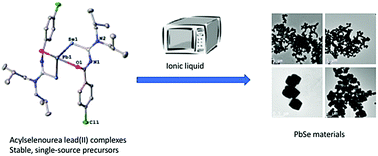
A joined publication (pdf) of the Mohr group and the Janiak group (University of Düsseldorf) recently described a new approach for microwave-assisted synthesis of lead selenide (PbSe) nanoparticles.
PbSe is one of the oldest known semiconductor materials. It has been used in the production of electronic and optoelectronic components for more than 100 years due to its excellent thermoelectric and semiconducting properties. Today`s applications include LEDs, photovoltaic cells and photodetectors.
Conventionally, it´s synthesis involves volatile and highly toxic precursors. Creating the need for an easy to handle single-source precursor for convenient and intrinsic control of the stoichiometry and reactivity.
The Mohr group combined their knowledge on microwave-assisted synthesis of various nanoparticles in ionic liquids with existing research on PbSe nanoparticle synthesis using acylselenourea lead(ii) complexes. Using TEM and SEM analysis, they showed the formation of nanoparticles, sub-microstructures or strongly aggregated and intergrown structures depending on the stabilizing reagent added.
30.05.2020
Estimating the Length of the Effectively Conjugated Segment in LPPP Ladder Polymers Reliably
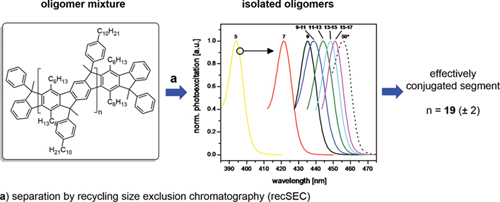
Conjugated Polymers, that means polymers with uninterrupted p-conjugation in the main chain, are a research focus of the Scherf group for over 30 years. Inscribing the single-stranded poly(para-phenylene) lead structure into the rigid framework of a double-stranded ladder polymer results in a distinctly reduced conformational diversity. These LPPP ladder polymers have been first reported by Scherf and Müllen (at this time at MPIP Mainz) in 1991.
A key parameter of such polymers is the so-called length of the effectively conjugated segment that indicates how many repeat units are electronically interacting. In the 1990ies, a value of 11-12 phenylene units was published, however, the underlying extrapolation was inaccurate and based only on a few data points.
In his master thesis Robin Ammenhäuser (BAYER award for his MSc thesis 2019) has isolated an extended series of LPPP model oligomers in a mix of synthesis of an oligomeric mixture and subsequent high pressure chromatographic oligomer separation. With the help of these oligomers he could specify the value for the length of the effectively conjugated segment to 19+/-2 phenylene units, a value that now correlates much better to the values of comparable, but structurally different polymers. The results have now been published in Organic Materials - a recently established new THIEME journal.
25.05.2020
Stability of plasma oxilipins using various plasma generation protocols
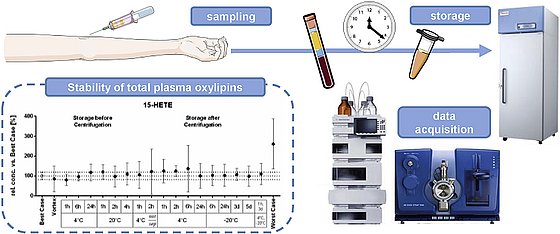
Elisabeth Koch and Malwina Mainka – two members of the Schebb Lab - recently published an article (full text) on the stability of plasma oxilipins.
Oxilipins are oxydized unsaturated fatty acids. They are known lipid mediators involved in the regulation of various physiological functions (such as inflammation, blood coagulation, vascular tone and endothelial permeability). The AG Schebb used a liquid chromatography-mass spectrometry method to detect the oxylipin profiles of plasma samples. They were able to show that the total levels of plasma oxylipins are stable regarding variations in the plasma generation protocol and long-term-storage.
This publication provides a basis for future studies on the influence of oxylipins on health and disease as well as their potential as biomarkers.
06.05.2020
ATMOS - Research into air pollution
The research teams of Prof. Per Jensen and Prof. Thorsten Benter will take part in the ATMOS consortium. This project is part of the Horizon 2020 initiative funded by the European Commission. It aims to promote research into air pollution by encouraging international cooperations as well as the training of young researchers. Additional details are provided here.
30.04.20
Influence of structural parameters on CPE chain dynamics and ion conductivity
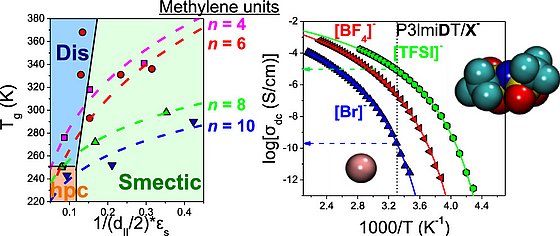
Since many years the Scherf group collaborates with the polymer physics group of Prof. George Floudas (University of Ioannina/Greece and Max-Planck-Institut für Polymerforschung/Mainz) in the systematic investigation of ionic polymers (so-called conjugated polyelectrolytes CPEs). While the synthetic work is carried out in the Scherf group (synthesis of polythiophene-based, cationic CPEs under variation of backbone-cation distance and size of the counterions), the characterization of chain dynamics and ion conducting properties is done in the Floudas group.
The now published results (full text) paint a conclusive picture how the structural parameters under investigation influence chain dynamics and ion conduction behavior. They also provide a reliable ion conduction model. The highest ion conductivities have been extracted for medium-sized, non-interacting counter anions as TFSI. Ongoing investigations are now focused on extending the investigations to zwitterionic CPEs, CPEs without mobile counter ions. The results demonstrate the crucial role of interdisciplinary collaboration in modern materials science.
22.04.20
Synthesis of rubazonic acid dyes
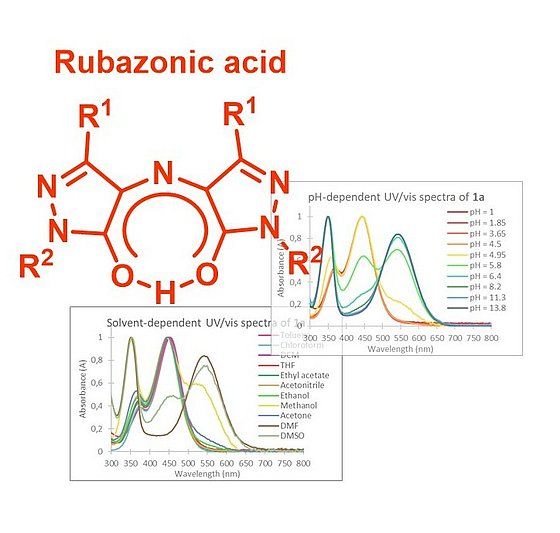
The Kirsch group developed a one-pot procedure for rubazonic acid synthesis (full text). Rubazonic acid is a red dye with possible implications in sensors or materials. Although known since 1887, studies on rubazonic acid and its derivatives are scarce due to a lack of methods for their synthesis.
Starting from pyrazolones, the Kirsch group used sodium azide to diazidate in the presence of iodine in dimethyl sulfoxide. The diazidated products were dimerized using a reducing agent (saturated aqueous sodium thiosulfate solution) to convert them into the desired dyes. Prof. Kirsch`s team was able to archieve moderate to good yields for rubazonic acid derivatives with a range of different substituents. Additionally, they developed an alternative two-step approach for more challenging substrates. Their publication increases the access to these dyes and their availability for future research and applications.
17.04.2020
New DFG Grant

The Gómez-Suárez lab recently received funding from the DFG. Their project "Radical-Based Synthesis & Derivatization of Enantiopure Amino Acid" aims to devise modular strategies to synthezise complex molecules and natural substances.
10.04.20
Synthesis of unnatural amino acids using radical chemistry
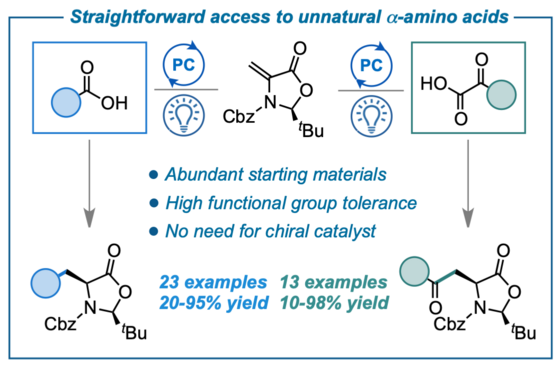
The Gómez-Suárez group recently published a mild, straight-forward and dependable method for light-induced synthesis of unnatural aminoacids using radical chemistry (full text).
Unnatural aminoacids can be used for a wide range of applications. They are valuable building blocks in the synthesis of biologically active substances for pharmaceutical as well as agricultural purposes. The new radical chemistry methods used here allow a controlled synthesis while preserving stereochemical information. This presents a huge advantage as the spatial structure of a compound may have major impact on its function.
